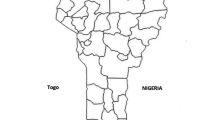Summary
Serological investigation by the indirect haemagglutination test forToxoplasma antibodies was carried out in a flock of dairy goats. Antibody titres ranging from 1:4 to 1:1,024 were found in 34% of 371 apparently healthy animals. High antibody titres of 1:256 suggestive of recent infection were noted in 18 (4.9%) animals including 13 nannies. The occurrence of a number of non-brucella abortions associated with high serological titres and the isolation of the parasite from the brain tissues of an aborted foetus suggestedToxoplasma as a probable aetiologic factor. Sera having significant levels of haemagglutinating antibodies (≥1:128) were also found positive to the card agglutination test. Epidemiological aspects and the public health potential of subclinical toxoplasmosis in dairy goats are discussed.
Résumé
Des investigations sérologiques par la méthode de l'agglutination indirecte pour rechercher des anticorps toxoplasmiques ont été faites sur un troupeau de chèvres laitières. Des anticorps ont été mis en évidence chez 34 p.100 des 371 animaux apparemment sains à des titres allant de 1:4 à 1:1024. Des titres élevés d'anticorps atteignant 1:256 ont été relevés chez 18 (soit 4,9 p.100) des animaux comprenant 13 chèvres, ce qui fait penser à une infection récente.
L'existence de nombre d'avortements non-brucelliques associés avec des titres sérologiques élevés et l'isolement du parasite des tittus cérébraux d'un foetus avorté suggerent que les Toxoplasmes en ont probablement été le facteur étiologique. Des sérums ayant des taux significativement élevés d'anticorps agglutinants (1:128) ont également été reconnus comme positifs par le test d'agglutination en EAT. Les aspects épidémiologiques et le danger potentiel pour l'homme de ces cas subcliniques de toxoplasmose chez les chèvres laitières sont discutés.
Resumen
Se realizaron investigaciones serológicas de toxoplasmosis mediante la prueba indirecta de hemaglutinación en un rebaño de cabras lecheras. Se encontraron títulos de 1:4 a 1:1024 en 34% de 371 animales aparentemente sanos. Títulos de 1:256 sugestivos de infecciones recientes, se encontraron en 18 (4.9%) animales, incluyendo 13 hembras paridas. La ocurrencia de un significativo número de abortos no asociados con brucela, títulos serológicos altos de toxoplasmosis y el aislamiento del parásito del cerebro de fetos abortados, sugiere que eltoxoplasma es el factor etiológico más importante. Se discuten aspectos epidemiológicos de importantcia para la salud pública, relacionados con el potencial de la toxoplasmosis (subclínica) en cabras lecheras.
Similar content being viewed by others
References
Angeloff, S., Galaboff, S., Gigoff, A. &Nikoloff, P. (1957).Comptes Rendus de l'Academie des Sciences Agricoles en Bulgarie,10, 329–332. (Veterinary Bulletin,29, abst. no. 1039.)
Beverley, J. K. A. (1974).Parasitic Zoonoses (Ed. E. J. L. Soulsby), Academic Press, New York, pp. 1–25.
Beverley, J. K. A. (1976).Veterinary Record,99, 123–127.
Bhardwaj, R. M. (1974). Studies on the prevalence, some aspects of pathogenesis, immunity and diagnosis of toxoplasmosis. PhD dissertation, Haryana Agricultural University, Hissar.
Cross, J. H., Van Peenen, P. F. D., Hsu, N. H. M., Koesharjono, C., Simanjuntak, G. M. &Amdani, S. K. (1976).Tropical and Geographical Medicine,28, 355–358.
Desmonts, G., Couvreur, J., Allison, F., Baudelot, J., Gerbeaux, J. &Lelong, M. (1965).Revue Francaise Etudes Cliniques et Biologiques,10, 952–958.
Dubey, J. P. &Streitel, R. H. (1976).Journal of American Veterinary Medical Association,169, 1197–1199.
Durfee, P. T., Cross, J. H. &Rustam, S. (1976).American Journal of Tropical Medicine and Hygiene,25, 42–47.
Feldman, H. A. &Miller, L. T. (1956).American Journal of Hygiene,64, 320–335.
Gill, H. S. &Prakash, O. (1970).Tropical and Geographical Medicine,22, 364–366.
Gupta, S. L., Gautam, O. P. &Bhardwaj, R. M. (1980).Tropical Animal Health and Production,12, 95–96.
Hartley, W. J. &Munday, B. L. (1974).Australian Veterinary Journal,50, 224–228.
Jacobs, L. (1973).Advances in Parasitology (Ed. Ben Dawes), Academic Press, London and New York, Vol. 11, pp. 631–659.
Jacobs, L. &Lunde, M. N. (1957).Journal of Parasitology,43, 308–314.
Jacobs, L., Remington, J. S. &Melton, M. L. (1960).Journal of Parasitology,46, 23–28.
Kagan, I. G. (1973). Parasitic diseases.Serological Epidemiology (Eds. J. Paul and C. White), Academic Press, New York, pp. 155–168.
Kozojed, V., Blazek, K. &Amin, A. (1976).Folia Parasitologia,23, 273–275.
Munday, B. L. &Mason, R. W. (1979).Australian Veterinary Journal,55, 485–487.
Prakash, O. (1966).Indian Journal of Medical Research,54, 437–442.
Riemann, H. P., Meyer, M. E., Theis, J. H., Kelso, G. &Behymer, D. E. (1975).Journal of Pediatrics,87, 573–576.
Sharma, S. P. &Gautam, O. P. (1972).Tropical Animal Health and Production,4, 245–248.
Tizard, I. R., Carrington, M. &Lai, C. H. (1977).Canadian Veterinary Journal,18, 274–277.
Vanderwagan, L. C., Behymer, D. E., Riemann, H. P. &Franti, C. E. (1974).Journal of American Veterinary Medical Association,164, 1034–1037.
Author information
Authors and Affiliations
Rights and permissions
About this article
Cite this article
Chhabra, M.B., Bhardwaj, R.M., Gautam, O.P. et al. Toxoplasma infection and abortion in dairy goats. Trop Anim Health Prod 13, 222–226 (1981). https://doi.org/10.1007/BF02237931
Accepted:
Issue Date:
DOI: https://doi.org/10.1007/BF02237931



